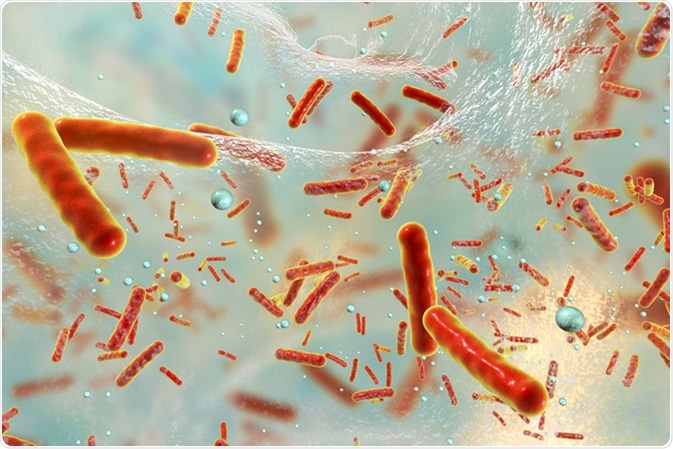A biofilm is a community of microbes on a surface that is encased in a polymer coating. Bacteria that grow attached to surfaces rather than floating in a liquid are called sessile. Most bacteria in nature are sessile, and aggregates of sessile bacteria can form biofilms.

Antibiotic resistant bacteria inside a biofilm, 3D illustration. Biofilm is a community of bacteria where they aquire antibiotic resistance and communicate with each other by quorum sensing molecules. Image Credit: Kateryna Kon / Shutterstock
In the human body, bacterial biofilms can be found on many surfaces such as the skin, teeth, and mucosa. Plaque that forms on teeth is an example of a biofilm.
Most bacteria are capable of forming biofilms. However, certain species have more of a disposition toward biofilms than others. In addition to plaque-forming bacteria on teeth, streptococci staphylococci, and lactobacilli also frequently form biofilms.
What Are Bacterial Biofilms? A Six Minute Montage
How do Bacterial Biofilms Cause Disease?
Biofilms can also form on implantable medical devices. Devices that partially penetrate the skin, such as a central venous catheter, can become coated with bacterial biofilms. Biofilms can form on fully implanted devices such as artificial hip or knee joints too. Urinary catheters frequently have biofilms of Escherichia coli, for example.
A species that is not a normal part of the microflora of the body, but which can form biofilms and cause infections, is Pseudomonas aeruginosa. It readily forms biofilms and can lead to infections of organs such as skin and lungs.
Infections related to biofilms can cause significant morbidity and mortality. The most vulnerable patients are those with implantable medical devices and those with a weakened immune system. The infections can be difficult to treat. This is because the immune system does not deal well with biofilms and biofilms are almost 1000 times more resistant to antibiotics than free-floating bacteria. In the case of infections caused by implantable medical devices, the device is often removed.
Can Biofilms Protect from Disease?
Some biofilms also protect against disease. For example, the vagina is covered with a biofilm of lactobacilli which prevents colonization by pathogenic bacteria. A disruption of the vaginal biofilm can lead to infection. Another example is a biofilm of healthy bacteria on the teeth, which prevents colonization by pathogenic bacteria.
Formation of a Biofilm
Biofilms form in several stages. First, the bacteria accumulates on a surface. They may arrive at the surface through random motions or be carried by the flow of a fluid suspension. If the organism is motile, they can be guided to the surface by a chemotactic or other mechanism.
The bacteria rarely adheres to the substratum directly. Instead, it deposits a layer of molecules known as a conditioning film. The bacteria then adheres to the conditioning film.
Adhesion to a surface alters the phenotype of the bacterium, changing activities like respiration, oxygen uptake, electron transport, synthesis of extracellular polymers, etc.
Once the bacteria have completed the adhesion phase, they enter colonization. In the colonization stage, the bacteria synthesizes extracellular matrix molecules and the number of attached bacteria is increased. These additional organisms may be the same or different species as the already-adhered cells.
The colonized cells then continue to grow leading to formation of dense bacterial aggregates. If parts of the biofilm are detached using mechanical or hydrodynamic force, they may re-adhere to the substratum leading to a spread of the colony.
Reviewed by Megan Knight, BSc
References
- Bacterial biofilms and human disease, https://www.ncbi.nlm.nih.gov/pubmed/11732158
- Microbial biofilm in human health - an updated theoretical and practical insight, https://content.sciendo.com/view/journals/rrlm/25/1/article-p9.xml
- Role for biofilms in infectious disease, https://asm.org/
- Microbial biofilms and gastrointestinal diseases, https://academic.oup.com/femspd/article/67/1/25/2367312
- Staphylococcus aureus biofilms, https://www.tandfonline.com/doi/full/10.4161/viru.2.5.17724?src=recsys
Further Reading
Last Updated: Jun 17, 2023